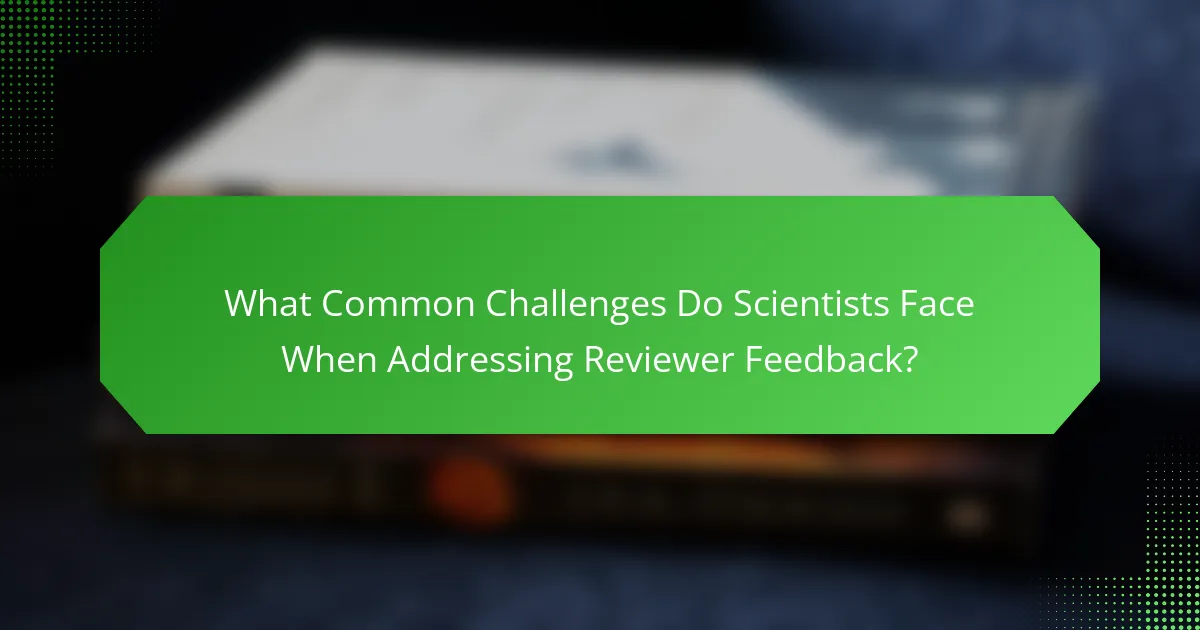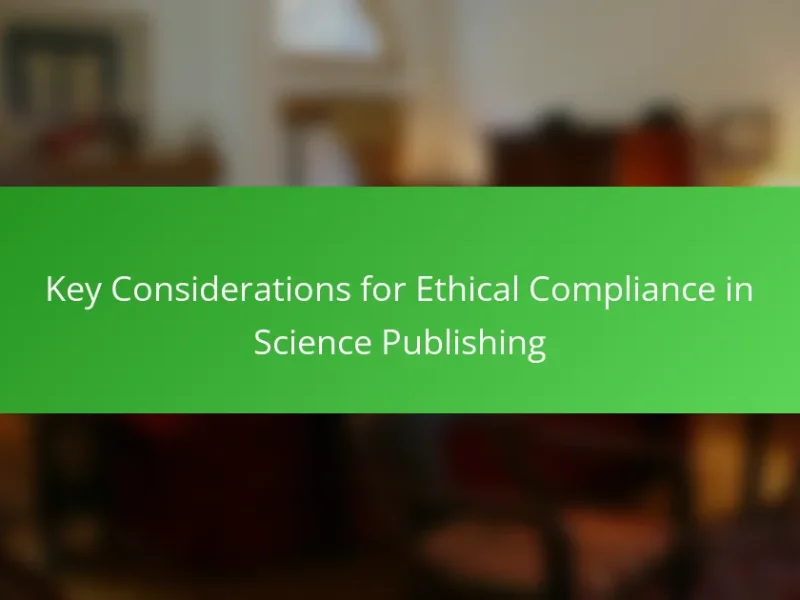Reviewer feedback is a critical component of the scientific research publication process, involving expert evaluations of submitted manuscripts to assess their quality, validity, and significance. This article provides a comprehensive guide for scientists on how to effectively address reviewer feedback, detailing strategies for understanding comments, categorizing issues, and responding to critiques. It also highlights common challenges faced during the revision process, such as conflicting feedback and emotional responses to criticism. By following the outlined strategies, scientists can enhance their manuscripts and maintain the integrity of their research while fostering constructive dialogue with reviewers.

What is Reviewer Feedback in Scientific Research?
Reviewer feedback in scientific research is the evaluation and critique provided by experts on a submitted manuscript. This feedback aims to assess the quality, validity, and significance of the research. Reviewers analyze various aspects, including methodology, data interpretation, and overall clarity. Their comments help authors improve their work before publication. Feedback can be positive, highlighting strengths, or constructive, pointing out weaknesses. It often includes suggestions for revisions or additional experiments. This process is essential for maintaining scientific rigor and integrity. Studies show that thorough reviewer feedback enhances the quality of published research.
How is Reviewer Feedback Collected and Processed?
Reviewer feedback is collected through structured processes such as surveys, direct communication, and feedback forms. Reviewers submit their insights after evaluating a manuscript or project. These submissions are often gathered via online platforms or email. The collected feedback is then organized and categorized for analysis.
Processing involves reviewing the comments for clarity and relevance. The feedback is assessed for actionable items and thematic trends. Authors typically receive a summary of the feedback along with specific comments. This structured approach ensures that all relevant points are addressed effectively.
What are the typical stages of the peer review process?
The typical stages of the peer review process include several key steps. First, the author submits the manuscript to a journal. Next, the journal editor evaluates the submission for relevance and quality. If deemed suitable, the editor sends the manuscript to expert reviewers. The reviewers assess the work, providing feedback and recommendations. After reviewing, the reviewers submit their reports to the editor. The editor then makes a decision based on the reviewers’ comments. This decision may be acceptance, revision, or rejection. Finally, the author receives the feedback and must address the comments before resubmission if revisions are required.
How do reviewers formulate their feedback?
Reviewers formulate their feedback by evaluating specific aspects of a manuscript. They assess clarity, methodology, and results. Reviewers often provide constructive criticism to improve the work. They reference relevant literature to support their comments. Feedback typically includes suggestions for additional experiments or analyses. Reviewers aim to enhance the manuscript’s quality and impact. Their evaluations are guided by journal standards and peer-review criteria. This process ensures scientific rigor and integrity in published research.
Why is Addressing Reviewer Feedback Important?
Addressing reviewer feedback is important because it enhances the quality of scientific work. Reviewers provide critical insights that can identify flaws or gaps in research. Incorporating their suggestions often leads to stronger arguments and clearer conclusions. This process can improve the chances of publication in reputable journals. Furthermore, addressing feedback demonstrates professionalism and respect for the peer review process. Research indicates that manuscripts revised based on reviewer comments have higher acceptance rates. Engaging with feedback can also foster collaboration and networking opportunities within the scientific community.
What impact does reviewer feedback have on research quality?
Reviewer feedback significantly enhances research quality. It provides critical evaluations that identify flaws and areas for improvement. Reviewers often highlight methodological weaknesses or gaps in literature. This feedback encourages authors to refine their hypotheses and analyses. Constructive criticism can lead to more rigorous and reliable results. Studies show that peer-reviewed articles generally have higher citation rates. This is indicative of their quality and impact on the field. Enhanced research quality ultimately contributes to scientific progress and knowledge dissemination.
How can addressing feedback improve publication chances?
Addressing feedback can significantly improve publication chances by enhancing the quality of the manuscript. Feedback often highlights areas that need clarification or improvement. By making necessary revisions, authors demonstrate their responsiveness to reviewers’ concerns. This responsiveness can lead to a more favorable evaluation from editors and reviewers. Research shows that manuscripts that incorporate reviewer feedback have higher acceptance rates. For example, a study in the journal “Nature” indicated that addressing reviewer comments improved acceptance rates by up to 30%. Thus, effectively addressing feedback aligns the manuscript more closely with publication standards.

What Strategies Can Scientists Use to Address Reviewer Feedback?
Scientists can use several strategies to address reviewer feedback effectively. First, they should carefully read and understand each comment. This ensures that they accurately grasp the reviewer’s concerns. Next, they can categorize feedback into major and minor issues. This helps prioritize revisions based on the feedback’s significance.
Additionally, scientists should respond to each point individually in their rebuttal letter. This demonstrates that they value the reviewer’s input. They can also provide clear explanations for any disagreements. If a suggestion is not implemented, a rationale should be included.
Furthermore, scientists can consult colleagues for additional perspectives on the feedback. This can lead to improved revisions and a more robust manuscript. Lastly, they should remain professional and courteous throughout the revision process. Maintaining a positive tone can foster constructive dialogue with reviewers.
How should scientists prioritize reviewer comments?
Scientists should prioritize reviewer comments based on their impact on the manuscript’s clarity and scientific validity. Comments that address critical flaws, such as methodological issues or data misinterpretation, should be addressed first. Next, comments related to the overall structure and organization of the paper should be considered. These adjustments enhance readability and coherence. Finally, minor suggestions, such as grammatical corrections or stylistic preferences, can be addressed last. This prioritization ensures that the most significant issues are resolved first, leading to a stronger manuscript.
What criteria can help in categorizing feedback?
Criteria for categorizing feedback include source, type, urgency, and relevance. Source refers to who provided the feedback, such as peers, mentors, or reviewers. Type categorizes feedback into positive, negative, or constructive comments. Urgency indicates how quickly feedback needs to be addressed, ranging from immediate to long-term considerations. Relevance assesses how applicable the feedback is to the specific work or project. These criteria help scientists prioritize and organize feedback effectively for better response strategies.
How can feedback be ranked in terms of importance?
Feedback can be ranked in terms of importance by evaluating its relevance, specificity, and potential impact. Relevant feedback directly relates to the research question or hypothesis. Specific feedback provides clear, actionable suggestions rather than vague criticisms. Potential impact assesses how the feedback could enhance the study’s clarity, validity, or overall contribution to the field. Prioritizing feedback that meets these criteria ensures that scientists focus on the most critical aspects of their work. This approach aligns with best practices in scientific communication and peer review.
What are Effective Techniques for Responding to Reviewer Feedback?
Effective techniques for responding to reviewer feedback include acknowledging the reviewers’ comments, addressing each point specifically, and providing clear explanations for any disagreements. Acknowledgment shows respect for the reviewers’ time and effort. Addressing points specifically ensures that all concerns are considered. Providing clear explanations helps clarify your stance and rationale. It is also beneficial to maintain a professional tone throughout the response. Additionally, revising the manuscript based on feedback demonstrates a willingness to improve. These techniques enhance the likelihood of a positive outcome in the review process.
How can scientists craft a professional response letter?
Scientists can craft a professional response letter by following a structured approach. First, they should begin with a polite salutation addressing the reviewer. Next, they need to thank the reviewer for their feedback and acknowledge specific points raised. Clarity is crucial; scientists should provide clear, concise responses to each comment. They should reference the manuscript sections related to the feedback. If changes were made, they should describe these changes explicitly. If a comment is not addressed, a clear rationale should be provided. Finally, a courteous closing statement should be included. This method ensures professionalism and demonstrates respect for the review process.
What tone should be used when addressing criticisms?
A respectful and constructive tone should be used when addressing criticisms. This tone fosters a positive dialogue and encourages collaboration. Acknowledging the reviewer’s perspective demonstrates professionalism. It is important to remain calm and avoid defensive language. Providing clear, evidence-based responses can strengthen your position. Using a solution-oriented approach helps to address concerns effectively. This method is supported by research indicating that constructive feedback leads to improved outcomes.

What Common Challenges Do Scientists Face When Addressing Reviewer Feedback?
Scientists often face challenges such as conflicting feedback from multiple reviewers. This can lead to confusion about how to revise their work. Additionally, reviewers may request extensive changes that require significant time and effort. Limited understanding of the reviewer’s perspective can complicate the revision process. Some scientists struggle with emotional responses to criticism, which can hinder their ability to address feedback objectively. Furthermore, the pressure to meet deadlines can impact the quality of revisions. Lastly, inadequate communication with reviewers can result in misunderstandings about their expectations. These challenges collectively complicate the process of addressing reviewer feedback effectively.
How can scientists handle conflicting reviewer comments?
Scientists can handle conflicting reviewer comments by systematically addressing each point raised. First, they should carefully read all comments to understand the differences. Next, scientists can categorize the comments into themes, such as methodology or interpretation. This helps identify which areas require more clarification.
Then, scientists should respond to each reviewer individually. They can explain their rationale for their original decisions or make adjustments based on the feedback. Providing evidence from literature or data can support their responses.
In cases where comments are fundamentally opposed, scientists can propose a compromise or state their position clearly. They can also seek advice from colleagues for additional perspectives.
Finally, a polite and professional tone in responses is crucial. This approach fosters constructive dialogue and improves the chances of a successful revision.
What strategies can be applied to reconcile differing opinions?
Active listening promotes understanding by allowing each party to express their views. This strategy helps identify common ground and underlying concerns. Facilitating open dialogue encourages participants to share their perspectives without interruption. This approach fosters an environment of respect and collaboration. Compromise involves finding a middle ground that satisfies both parties. This strategy often requires flexibility and willingness to adjust positions. Mediation by a neutral third party can help manage conflicts effectively. This external facilitator can guide the discussion and ensure fairness. Documenting agreements solidifies the reconciliation process. This practice provides a reference point for future discussions.
How should scientists respond to feedback they disagree with?
Scientists should approach feedback they disagree with constructively. They should first carefully read the feedback to understand the reviewer’s perspective. Identifying the specific points of disagreement is essential. Scientists can then evaluate the feedback against their research and data. If the feedback highlights valid concerns, they should consider making necessary adjustments. If they maintain their stance, they should prepare a respectful and reasoned response. Citing relevant literature or data can strengthen their argument. This approach fosters a professional dialogue and enhances the quality of scientific discourse.
What are the best practices for incorporating feedback into research revisions?
The best practices for incorporating feedback into research revisions include systematically organizing the feedback received. Researchers should categorize feedback into themes such as content, methodology, and presentation. Each piece of feedback should be assessed for relevance and importance.
Prioritize addressing critical comments first. This approach ensures that the most significant issues are resolved early in the revision process. Researchers should also maintain a detailed response document. This document should outline how each piece of feedback was addressed or why it was not incorporated.
Engaging with co-authors for their insights can enhance the revision process. Collaboration often brings new perspectives that strengthen the research. Finally, revisiting the research objectives and ensuring alignment with the feedback is crucial. This alignment ensures that the revisions enhance the overall quality and clarity of the research.
How can scientists ensure all comments are adequately addressed?
Scientists can ensure all comments are adequately addressed by systematically organizing feedback. They should categorize comments into major and minor issues. This helps prioritize which comments require more detailed responses.
Next, scientists should draft a point-by-point response to each comment. They can reference specific sections of their manuscript where changes have been made. This clarity improves the review process.
Additionally, maintaining a dialogue with reviewers can be beneficial. Asking for clarification on ambiguous comments can lead to better understanding and resolution.
Finally, thorough documentation of responses is crucial. Keeping a record of all comments and responses ensures accountability. This methodical approach leads to a comprehensive addressing of all reviewer feedback.
What tools or resources can assist in managing revisions?
Version control systems like Git assist in managing revisions effectively. These tools track changes and allow multiple users to collaborate. Google Docs provides real-time editing and commenting features. This enables easy feedback integration and revision tracking. Reference management software, such as EndNote or Mendeley, helps organize citations during revisions. Project management tools like Trello or Asana can help plan and track revision tasks. Utilizing these resources enhances efficiency and accuracy in the revision process.
What Practical Tips Can Help Scientists Navigate Reviewer Feedback?
To navigate reviewer feedback effectively, scientists should first read comments thoroughly. Understanding the feedback is crucial for addressing concerns. Next, categorize feedback into major and minor points. Major points often require significant revisions. Minor points may involve simpler adjustments.
Scientists should respond to each comment systematically. A detailed response letter can clarify how each point was addressed. It is also beneficial to maintain a positive tone throughout the revisions. Engaging constructively with reviewers fosters a collaborative atmosphere.
Additionally, seeking input from colleagues can provide fresh perspectives. They may identify areas for improvement that the original author overlooked. Lastly, revisiting the manuscript after some time can help in assessing the feedback with a clearer mind. This process enhances the quality of the final submission.
The main entity of this article is reviewer feedback in scientific research. The article provides a comprehensive guide for scientists on how to effectively address reviewer feedback to enhance the quality of their manuscripts. It covers key aspects of the peer review process, including the collection and processing of feedback, strategies for prioritizing and responding to comments, and best practices for incorporating feedback into revisions. Additionally, it discusses common challenges faced by scientists when addressing feedback and offers practical tips for navigating these challenges to improve publication chances and overall research quality.


